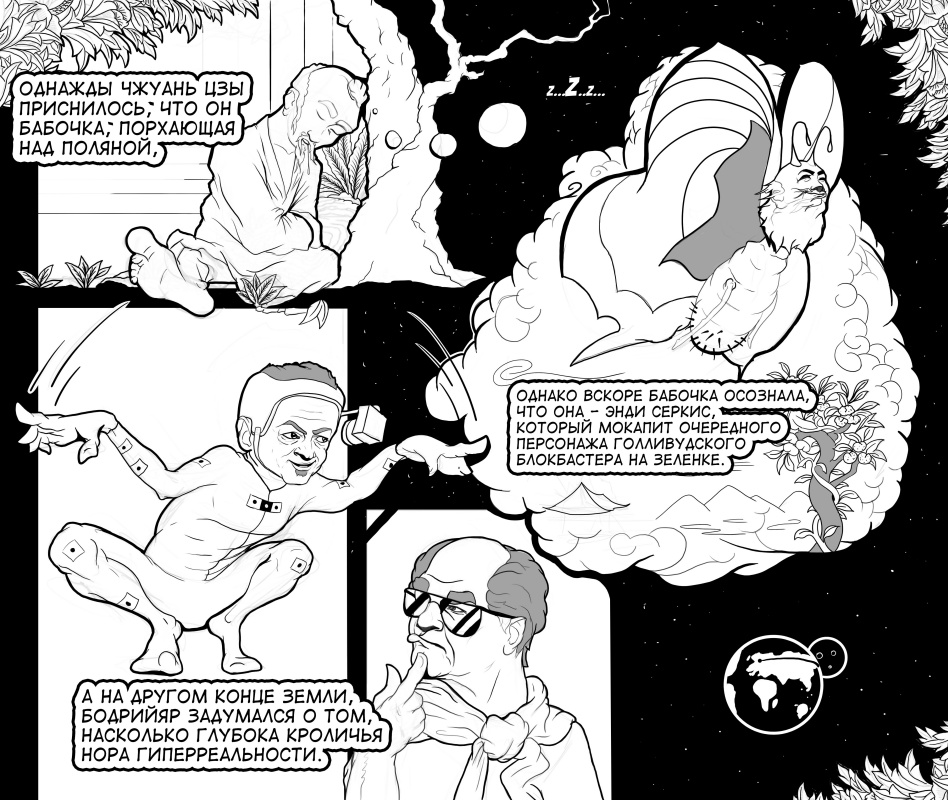log in
Enter site
Login to use Arthive functionality to the maximum
Simulation koan
Andrey Kornienko • Graphics, 2019
Description of the artwork «Simulation koan»
- What was the reality like before the third order of simulacres?
Reasoning about a simulative koan:
// For Zhuan Zi, it opened as visible through the eyes of a butterfly //
- If Zhuan Zi is the same butterfly, in what order of simulacra is he?
- In what order are we simulacra?
Jean Baudrillard talked about hyperreality, as something inherent exclusively in the information society. In his opinion, once there was some physical reality that was decomposed by representations of the real.
And they decomposed it until they themselves were digested by new representations referring to the representations themselves, which eventually gave rise to that state of hyperreality in which we live and cannot be sure about anything, but is it really really?
From the ancient Chinese culture we know the parable of the philosopher Zhuan Zi, who dreamed that he was a butterfly, which in turn made Zhuan Zi doubt the reality of his own perception. Who really dreams who? Butterfly Zhuan Zi or Zhuan Zi butterfly?
It would seem that in this situation there is nothing terrible that would foreshadow the collapse of the real, the parable is binary, at least one branch of perception of the Chinese philosopher is reality, and the second is a phantasm (which branch is the question that the parable puts the listener) and further first-order simulation reality is not destroyed.
But here it is worth looking from a different angle. What is a parable? In essence, this is a narrative that represents the idea through symbols. Those. just what a third-order simulacrum is a hyper-reality. That which refers to that which is not. If we assume that some kind of reality did exist, it ended at the moment when the parable was first formulated. And in the future it continued in the form of a representation for the representation, story, film, etc.
From this we can conclude that the state of hyperreality - for a person is quite natural. However, it is ironic that this state became destructive only at the moment when it was reflected.
What to do with it is an interesting question. And the truth is, what to do with what is not? Perhaps the answer lies where Zhuan Zi lies, snoring peacefully and seeing a dream about the fact that he is a butterfly fluttering over a clearing, or vice versa.
Reasoning about a simulative koan:
// For Zhuan Zi, it opened as visible through the eyes of a butterfly //
- If Zhuan Zi is the same butterfly, in what order of simulacra is he?
- In what order are we simulacra?
Jean Baudrillard talked about hyperreality, as something inherent exclusively in the information society. In his opinion, once there was some physical reality that was decomposed by representations of the real.
And they decomposed it until they themselves were digested by new representations referring to the representations themselves, which eventually gave rise to that state of hyperreality in which we live and cannot be sure about anything, but is it really really?
From the ancient Chinese culture we know the parable of the philosopher Zhuan Zi, who dreamed that he was a butterfly, which in turn made Zhuan Zi doubt the reality of his own perception. Who really dreams who? Butterfly Zhuan Zi or Zhuan Zi butterfly?
It would seem that in this situation there is nothing terrible that would foreshadow the collapse of the real, the parable is binary, at least one branch of perception of the Chinese philosopher is reality, and the second is a phantasm (which branch is the question that the parable puts the listener) and further first-order simulation reality is not destroyed.
But here it is worth looking from a different angle. What is a parable? In essence, this is a narrative that represents the idea through symbols. Those. just what a third-order simulacrum is a hyper-reality. That which refers to that which is not. If we assume that some kind of reality did exist, it ended at the moment when the parable was first formulated. And in the future it continued in the form of a representation for the representation, story, film, etc.
From this we can conclude that the state of hyperreality - for a person is quite natural. However, it is ironic that this state became destructive only at the moment when it was reflected.
What to do with it is an interesting question. And the truth is, what to do with what is not? Perhaps the answer lies where Zhuan Zi lies, snoring peacefully and seeing a dream about the fact that he is a butterfly fluttering over a clearing, or vice versa.


